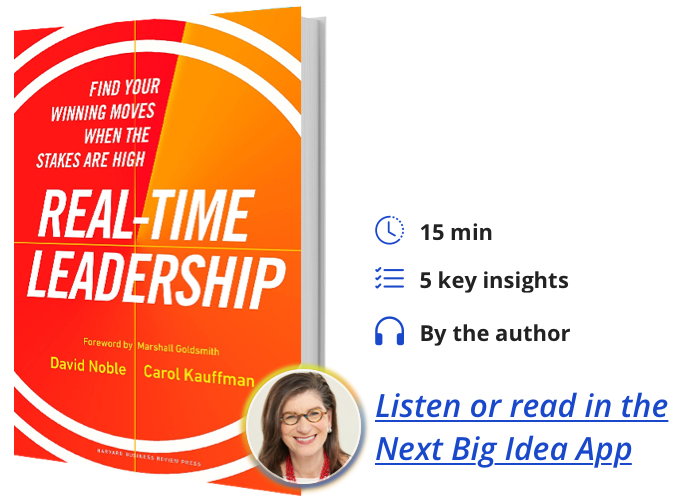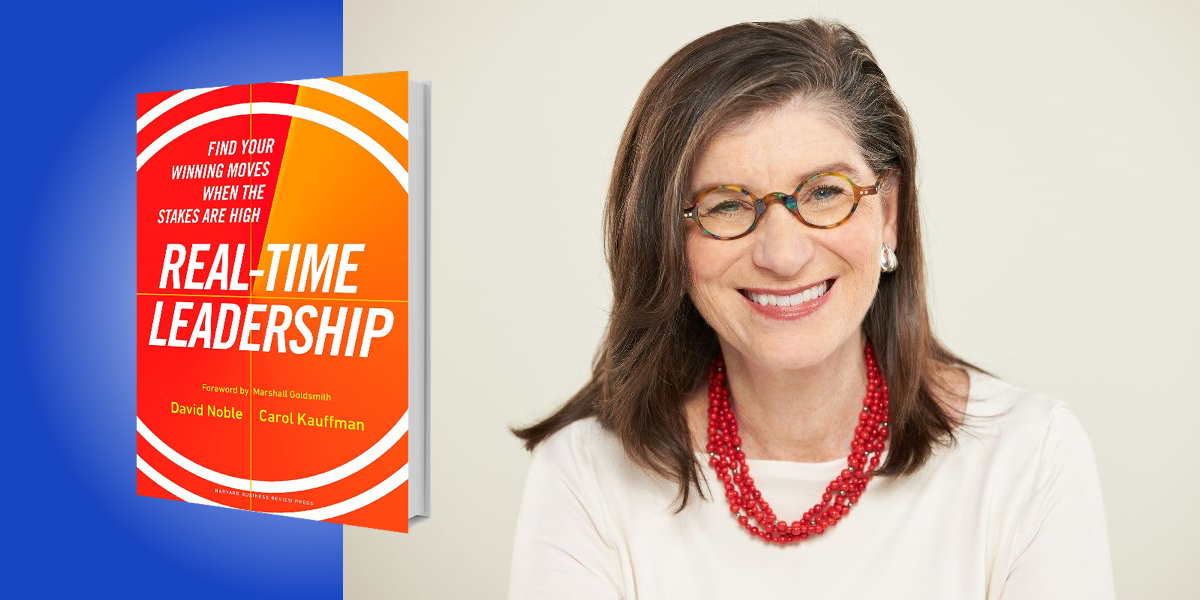David Noble is the founder of View Advisors, a consulting firm that works globally with organizations on leadership and strategy. He also serves as a senior adviser to Egon Zehnder, the Institute of Coaching, and Oliver Wyman Group. In 2021, he was named by Thinkers50 as one of the world’s top coaches. He is also a member of the Marshall Goldsmith 100 Coaches community of leaders and coaches.
Carol Kauffman is an international leader in the field of coaching. She is a founding member of Marshall Goldsmith 100 Coaches, where she was ranked as the number one leadership coach in the world. Carol is an assistant professor at Harvard Medical School, a visiting professor at Henley Business School, and a senior leadership adviser at Egon Zehnder. She is founder of the Institute of Coaching.
Below, David and Carol share 5 key insights from their new book, Real-Time Leadership: Find Your Winning Moves When the Stakes Are High. Listen to the audio version—read by Carol—in the Next Big Idea App.

1. The real-time leadership “MOVE” model.
We all have default reactions to things, and under pressure we become an exaggerated version of ourselves. We are then vulnerable to slide into our automatic ways of reacting. Often these do not serve us, or those we lead and care about. It’s important to learn to make inner space, so as to defy your default mode of acting, allowing you to make the most of every moment.
Finding your winning moves when the stakes are high means being able to have choices at your fingertips when you need them. Victor Frankl wrote that there’s a space between stimulus and response, and in that space is our freedom. But, what can you do with that freedom? What should you focus on, what lifelines do you need to hold onto? Can you slow time down, look around, and gain sense of what you need to focus on? Can you identify what really needs to get done, what inner resources you can access? Are you able to see others clearly, connect with them, and send the right signals? If you could, what would that be like? How much would that serve you?
Here are three examples of stimuli: You are in a major interview and you’re tanking. Will you go into default mode, or can you make a space? You are with a coworker or an extended family member and suddenly they start spouting opinions that are toxic to you. Will you go into default mode, or can you make a space? You want to buy a house or acquire a company and your finances are strained. Will you go into default mode, or can you make a space?
We have a number of ways to help make space, defy your default mode, and find freedom to make the choices you want. We summarize everything we know and clumped it into an acronym so you could remember it in real-time: M.O.V.E.
2. Be mindfully alert.
The “M” in the “M.O.V.E. acronym is for being mindfully alert. In leadership and in life, there are always three dimensions of leadership. Mindful is noticing what is around you in a non-judgmental way, or what we call beginner’s mind. We also need to develop being highly alert, like an athlete operating in the zone. Being mindfully alert allows you to be attuned to what is going on around you, inside you, and with others, and respond in an agile, accurate manner.
We want to be mindfully alert, but to what? Each leadership moment or decision you need to make has three dimensions and whether you are aware of it or not, they are inextricably linked. You need to be clear on the external demands, (what you need to achieve), the internal challenges, and the capacity to be your best self and make wise interpersonal choices. So how do you need do this?
“You can create space and have more freedom to choose.”
The research is pretty clear. If you just pause and name these things, articulating them to yourself, you’re more able to manage yourself and what’s going on. You can create space and have more freedom to choose. To make that space ask yourself three questions: What do you need to do? Who do you need to be? How do you need to relate?
The first question involves the external and it might seem obvious. Think of tanking in that interview. Did you get those external challenge wrong? You may have thought your job was to wow them with everything you know, but maybe it was to communicate your passion and make them feel they matter.
The second question involves the internal challenges. You’re in that awful moment, who do you want to be? Have you invested enough in knowing who you are to draw upon it under high stakes stress? Have you been living your values and purpose enough to pull on them as resources right now? If so, as you are tanking in that interview, could you look the negativity in the eye and put it in perspective? What would happen then? You’d step into a different state of mind and, perhaps, stop tanking.
The third question involves your relationship between the internal and external. How do you need to relate? Is the golden rule the highest standard? To treat others as you would want to be treated? No, we need to step up to the platinum rule. Treat others as they would want to be treated, which may be quite different from what you would want. Perhaps in this case, as you were tanking you might notice, “I’m talking with high energy in entertaining story telling mode.” If you were mindfully alert, you might notice they need you to downshift and create a calmer atmosphere in order for them to absorb your message. In the quest to find the space between stimulus and response, step into being mindfully alert and build up your capacity to identify the three dimensions of leadership.
3. Be an options generator.
Our primary reflexes are fight, flight, freeze and befriend. Each of us tends to have a typical stance that we take of approaching or avoiding challenges—our default mode. While your reflex might be correct most of the time, we don’t want to be locked into our first response. We need to make space to overcome our reflexes.
Generating options helps you identify your default and train yourself to go beyond it, to defy going into autopilot. The language we use for the different stances we can take is when something is thrown at you—do you lean in, lean back, lean with, or not lean at all?
Leaning in is basically actively engaging. If there’s a conflict, it means having the courage to take it on. You can lean in with enthusiasm or aggression. You can lean in like a rugby player or a ballerina.
Leaning back is looking from a more objective, rational place. It feels like going up onto the balcony and looking at the overview and the data and working around conflict if possible.
The third option is to lean with. This would be to focus on people first, to nurture and care. You hone into what the other person needs, or in a larger scale, on what the culture needs.
“Generating options helps you identify your default and train yourself to go beyond it, to defy going into autopilot.”
The last and hardest option is actually not leaning at all. When something is thrown at you, you have the discipline to not react, but to pause instead. To make a space. Then let the solution come to you. In essence, these help you access four strategies on how to approach a challenge.
For example, take a coworker with toxic opinions. Consider which action you would most likely take. Now what would a different choice be like, and could you do it? It might be to lean in—confront the challenge head-on and thrash out the issues with a debate. Or, maybe you would want to lean back, consider the risks of speaking, decide what’s most rational, and figure out what would work best. Or do you want to lean with and try to connect despite the difference, and understand their point of view? Could you choose to not lean at all—let it go and not engage, but not zone out either? Would you have the capacity to not be triggered by their view?
4. Validate your vantage point.
The person who can see reality for what it is first has the advantage. What is an ideal vantage point? Being clear, having the right resolution, breadth and depth.
To see clearly means you’re not farsighted or nearsighted, you don’t have on rose-colored or charcoal-colored glasses. Right resolution means you’re expending the right amount of energy and are able to adjust the intensity of your attention. Some things need high resolution, others can be grainy with no harm done.
When you are assessing what to do, or how important an issue may be, it’s best to have a broad scope. But how high up, exactly, do you need to go to get the best perspective? Do you need to be a hawk or a hummingbird in the situation?
Take, for example, a situation where you’re going to buy a house or a company. Have you collected the right information to have a clear view so that you’re not overly optimistic or pessimistic? Are you paying attention to the right things at the right level—knowing where you need that high-definition view and get super clear—or where it’s okay to slide over something? Have you looked widely enough in this situation? Done your due diligence? Do you need to go down further and get close up?
“When you are assessing what to do, or how important an issue may be, it’s best to have a broad scope.”
Equally important are the intangibles. What forces can interfere with your ability to have a clear vantage point? What can distort your view? These are dangerous, as they can’t be seen with our eyes but with our hearts, minds, and gut reactions. We tend to fill in the dots with our hopes and our fears, but instead need to work on being centered and clear.
Do you know how your personality or cognitive style impacts what you think you see? Are you aware that you have unconscious biases? Many factors can distort your view, causing you to exaggerate or minimize threat or opportunity or give you blind spots. Are you aware of the whole world of things that you don’t know? The person who can see reality for what it is has the advantage.
5. Engage and effect change.
How do you create space for others? As a leader, you shouldn’t make people read your mind. Often, we think that other people understand us, that they know what we do. We have to take responsibility to identify that gap between what we know and what others do. Often, we don’t know our own strength and run so fast that others can’t follow. Like supermen or women, we think we’re just shaking someone’s hand but they walk away with broken fingers. Our job is to draw out the superpowers of others.
What can we do so we don’t accidentally require people to read our minds? A core leadership skill is to be clear on our intent, to convey our vision, our top priorities. We need to make space so we know the basics of who, what, when, where, and why.
You need to put out a clear signal on what you want. That doesn’t mean to take over. Everyone on the team needs to identify what is to be done together and iterate to the best solution. Ideally everyone on your team should be able to articulate your intent, and you should be able to articulate theirs.
As a leader you need to be re careful as people will often jump to conclusions about what you want. There are ways to help avoid this—one is signposting. It cues others to know what kind of conversation you are having. Say you’re at the table with your direct reports. You may think you’re just brainstorming, but then are shocked afterward to find everyone is running around executing on tasks they believe you’ve given them. Signposting helps with that. You can signpost by saying, “This is a time for idea generation, we’ll make decisions later.” You can also say, “Let’s gather information and decide what to do before we leave the room.”
These are many ways to help you find the space between the stimulus and response, and have guidelines and frameworks so you can use your freedom well. You can make space by being mindfully alert to these three dimensions of leadership. You can generate options and have four ways to move forward. You can make more space by validating your vantage point to see things clearly and not being blindsided by things. You need to pull on what others see and not let your biases win the day. Finally, you need to engage and effect change, not make people read your mind.
To listen to the audio version read by co-author Carol Kauffman, download the Next Big Idea App today:






























